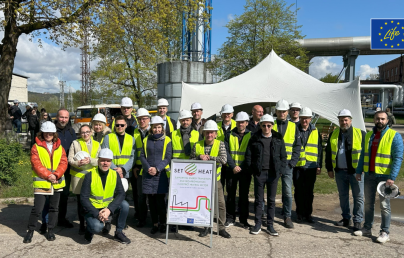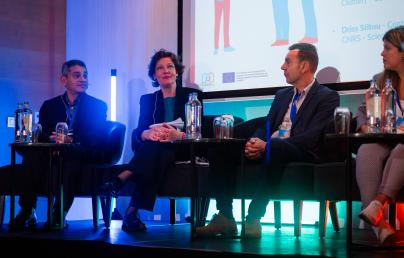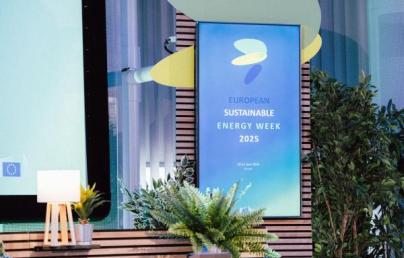
Jesús Lizana: ‘Two technologies will become extremely popular in Europe in the following decades, where innovation is moving rapidly. These technologies are related to fans and personal cooling devices’

Jesús Lizana: ‘Two technologies will become extremely popular in Europe in the following decades, where innovation is moving rapidly. These technologies are related to fans and personal cooling devices’
Building conversations up with... Jesús Lizana, Architect, Associate Professor at the University of Oxford.
Background
Jesus Lizana is an Associate Professor of Engineering Science at the University of Oxford and leads the research on zero-carbon space heating and cooling at the ZERO Institute. With a background in architecture and engineering, he has received numerous grants, including a Marie Curie Fellowship. Lizana supports interdisciplinary research in the Future of Cooling Programme and serves as a board member and scientific reviewer for leading journals and conferences. He also consults on global energy projects, providing guidance to institutions like UNEP and the Department for Energy in the UK. Lizana holds a PhD in low-carbon buildings from the University of Seville.
BUILD UP (BUP): With the projected increase in energy demand for space cooling, what are the primary strategies to mitigate this rise, and how effective are they?
Jesús Lizana (JL): The top three strategies to mitigate energy demand for cooling are solar protection, natural ventilation, and using more thermal comfort variables for cooling. For solar protection we can use reflective and ventilated roofs, external window shutters and awnings to reduce solar heat gains. Our studies in hot countries show that reflective surfaces (light-coloured paints) can reduce cooling needs by 4-7% and external window shutters by 10-15%.
Opening windows when the outside temperature drops can be an easy strategy to dissipate heat. Cross ventilation, where a fresh breeze enters through an opening and exits through another on the opposite side, will always be more effective. If necessary, ventilation can be promoted by incorporating inner courtyards which is a design used for centuries in warmer climates to keep buildings cool. Moreover, additional features, such as ventilation chimneys and roof vents, can be incorporated into building design to assist airflow further. Ventilation can extend cooling savings by up to 20-30%.
Cooling beyond temperature control is a very powerful alternative. Here's where fans become useful. By increasing the indoor airspeed using fans (ceiling or standing fans), we can create comfortable indoor environments at 27-28°C. This strategy can even be combined with air conditioning. For every degree of increase in the thermostat, we can get an additional 5-10% energy savings for cooling.
BUP: How do zero carbon space cooling and passive cooling differ in terms of their approaches and implementation, and what are the unique benefits and limitations of each?
JL: I don’t think they are different. Passive cooling is, and always will be, part of a zero-carbon cooling strategy. Combining both strategies can lead to optimal sustainability in building cooling systems.
Traditionally, passive cooling relies on design-centric strategies and natural processes to maintain comfortable indoor temperatures without the use of mechanical cooling systems. This includes solutions for solar protection, heat dissipation, heat modulation, and heat prevention. Conversely, zero-carbon space cooling can be understood as a technology-driven approach that uses high efficiency and renewable energy.
Of course, there are synergies and trade-offs when integrating both into the building design, and effectiveness will depend heavily on location and occupants’ behaviour, with a strong climate dependency. However, the target should always be an integrated design, using passive first to reduce cooling load, downsizing mechanical systems and mitigating the cooling energy demand.
‘Passive cooling is, and always will be, part of a zero-carbon cooling strategy. Combining both strategies can lead to optimal sustainability in building cooling systems’
BUP: What specific policies, incentives, and programs have the European Union introduced to promote the adoption of passive cooling techniques in both new and existing buildings?
JL: The European Union has implemented a range of policies, incentives, and programs to promote passive cooling. Key initiatives are the Energy Performance of Buildings Directive (EPBD), recently updated in 2024, to establish more strict and harmonised building standards across EU countries, such as the Renovation Wave Initiative for financing energy-efficient renovations and providing technical assistance. Different funding programmes, such as Horizon Europe and LIFE, fund research, innovation, and demonstration projects that focus on developing and implementing innovative passive cooling technologies and best practices in energy efficiency and climate adaptation. However, despite significant progress much work remains to be done to ensure climate adaptation is included in the built environment across Europe.
BUP: What are the key challenges in retrofitting existing buildings in Europe with passive cooling technologies, and how can these challenges be addressed to improve adoption rates?
JL: In Europe, we have an alarming situation in the existing built environment. When we create highly insulated buildings to reduce heating needs, we assume that most buildings use heating, ventilation, and air-conditioning (HVAC) systems. However, in scenarios without cooling systems (or not frequently used HVAC systems), insulation and airtightness prevent heat release when ventilation is inadequate, seriously increasing indoor overheating.
Indoor overheating is becoming a critical problem in northern countries, where buildings are traditionally prepared for the cold season. For example, we start suffering from this problem in Oxford every summer. In traditionally cool climates, buildings are designed to keep heat in by maximising solar gains (e.g. dark roofs, no external window shutters…) and minimising ventilation (e.g. windows locked, roofs not ventilated). Conversely, in summer when it is hot, buildings must do the opposite. Otherwise, we are creating greenhouses. In these regions we find that even with a moderate increase in temperatures compared to other countries, the impact of extra heat will be felt more acutely.
To mitigate this problem, a few countries have implemented new policies in building regulations, recognising the importance of the risk of overheating. Some examples are found in Germany, France and the United Kingdom. However, despite these efforts the methods are still poor compared with strong guidelines, such as CIBSE’s TM52 or TM59 standards. Moreover, in most cases these criteria don’t apply to existing buildings, and most importantly, they do not include future climate data in the analysis; we are still using historical climate observations to support the building design that will stand for the next century. All these facts drastically block climate adaptation in the existing building stock.
I strongly believe that European countries are not ready to tackle climate change. Current interventions are overlooking the building needs for the next decades. Cooling needs are increasing drastically, and we must maximise synergies between mitigation and adaptation strategies. Otherwise, air conditioning will always be the main alternative to rising temperatures.
‘I strongly believe that European countries are not ready to tackle climate change. Current interventions are overlooking the building needs for the next decades’
BUP: In what ways can passive cooling techniques enhance indoor air quality (IAQ), and what specific methods are most effective in achieving this improvement?
JL: There are many synergies between passive techniques and appropriate indoor air quality, mainly because they share a common issue: ventilation. Ventilation is crucial to create healthy homes. We spend 55 - 69% of our daily time at home, where we are exposed to indoor pollutants from cooking, cosmetics, paints, cleaning products, air fresheners, smoking, incense, wallpapers or even adhesives. In a recent study we identified that the highest exposure and inhalation of air pollutants (mainly from aldehydes and volatile organic compounds), occur in bedrooms, which account for 60 per cent of the daily inhaled dose. This primarily results from poor ventilation, high occupancy time, and a concentration of pollutant-emitting household products.
In this context, we find a solid opportunity to address two problems through adequate ventilation. There are many alternatives to address passive ventilation efficiently. Buildings can be designed to promote cross-ventilation. If necessary, this can be promoted by incorporating inner courtyards. Additional features, such as ventilation chimneys and roof vents, can also be incorporated to assist airflow further. Of course, solutions should be adapted to every climate. More examples are illustrated in Fig. 1.

Figure 1. Alternatives to promote natural ventilation in building design
BUP: Which passive cooling technologies show the greatest promise for widespread use in Europe, considering the continent's diverse climates and architectural styles, and what innovations are on the horizon?
JL: Two technologies will become extremely popular in Europe in the following decades, where innovation is moving rapidly. These technologies are related to fans and personal cooling devices. Integrating ceiling fans to increase airspeed will enable us to increase the set-point temperature from 24ºC to 27ºC without sacrificing thermal comfort. Moving from the classical approach, where cooling is only controlled by temperature to a hybrid approach integrating more comfort variables (Fig. 2), this solution can reduce energy consumption by more than 20% or even eliminate the need for an air conditioner. Novel fan technology, with innovative designs for integration, are appearing on the market, moving from traditional fans with blades to innovative solutions wholly integrated into the building design.
Additionally, there is a fast-growing market for personal cooling devices. From conventional personal/desk fans to radiant panels, cooled seats, or wearable air-conditioning devices, hundreds of new devices are becoming available for indoor or outdoor environments. The opportunity here is to achieve cooling savings by combining centralised and personalised environmental control systems. It is called an occupant-centric building design. The target is to decrease centralised cooling systems and create individual adaptive environments for user adaptability according to different cooling needs, reducing centralised power and energy demand without sacrificing comfort. Numerous studies have also highlighted the significant potential of this integration to address the common problems of overcooling occupants and wasting energy by cooling unoccupied rooms.

Figure 2. (a) Keeping cool only by temperature control; (b) using all thermal comfort variables. Source: Lizana et al (2022).
BUP: Can passive cooling techniques alone achieve the goal of decarbonising space cooling, or is it necessary to integrate these methods with other sustainable technologies? If so, what combinations are most effective?
JL: Passive cooling should always be part of the solution, but it will likely need to be integrated with other sustainable technologies to achieve net zero. We need to integrate all possible opportunities to achieve a cost-effective zero-carbon strategy. Here our recommendation is always to follow the right steps in the right order, as illustrated in Fig. 3. These steps consist of (1) solar protection, (2) heat dissipation, (3) heat modulation, (4) heat prevention, (5) smart management of more comfort variables, (6) occupant-centric technology, (7) focus on the life cycle, and (8) energy consumption based on renewable energy. These solutions, implemented following the right order, can increase the heat resilience of the built environment (steps 1-4), downsize cooling systems and cooling needs (steps 5-6), decrease resource consumption (step 7), and mitigate the environmental impact of cooling (step 8). Naturally, these measures should be implemented considering current and future weather conditions and the integration of heating and cooling in building design.
Figure 3. Portfolio of cooling techniques and technologies (a) and the recommended steps to address sustainable cooling (b). Source: Lizana et al. (2022)

